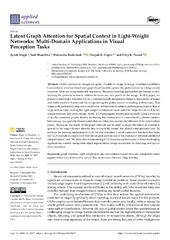| dc.contributor.author | Singh, Ayush | |
| dc.contributor.author | Bhambhu, Yash | |
| dc.contributor.author | Buckchash, Himanshu | |
| dc.contributor.author | Gupta, Deepak Kumar | |
| dc.contributor.author | Prasad, Dilip Kumar | |
| dc.date.accessioned | 2025-01-08T10:23:33Z | |
| dc.date.available | 2025-01-08T10:23:33Z | |
| dc.date.issued | 2024-11-19 | |
| dc.description.abstract | Global contexts in images are quite valuable in image-to-image translation problems.
Conventional attention-based and graph-based models capture the global context to a large extent;
however, these are computationally expensive. Moreover, existing approaches are limited to only
learning the pairwise semantic relation between any two points in the image. In this paper, we
present Latent Graph Attention (LGA), a computationally inexpensive (linear to the number of nodes)
and stable modular framework for incorporating the global context in existing architectures. This
framework particularly empowers small-scale architectures to achieve performance closer to that of
large architectures, making the light-weight architectures more useful for edge devices with lower
compute power and lower energy needs. LGA propagates information spatially using a network
of locally connected graphs, thereby facilitating the construction of a semantically coherent relation
between any two spatially distant points that also takes into account the influence of the intermediate
pixels. Moreover, the depth of the graph network can be used to adapt the extent of contextual
spread to the target dataset, thereby able to explicitly control the added computational cost. To
enhance the learning mechanism of LGA, we also introduce a novel contrastive loss term that helps
our LGA module to couple well with the original architecture at the expense of minimal additional
computational load. We show that incorporating LGA improves performance in three challenging
applications, namely transparent object segmentation, image restoration for dehazing and optical
flow estimation. | en_US |
| dc.identifier.citation | Singh, Bhambhu, Buckchash, Gupta, Prasad. Latent Graph Attention for Spatial Context in Light-Weight Networks: Multi-Domain Applications in Visual Perception Tasks. Applied Sciences. 2024;14(22) | en_US |
| dc.identifier.cristinID | FRIDAID 2332158 | |
| dc.identifier.doi | 10.3390/app142210677 | |
| dc.identifier.issn | 2076-3417 | |
| dc.identifier.uri | https://hdl.handle.net/10037/36111 | |
| dc.language.iso | eng | en_US |
| dc.publisher | MDPI | en_US |
| dc.relation.journal | Applied Sciences | |
| dc.relation.projectID | info:eu-repo/grantAgreement/EC/H2020/964800/EU/OrganVision: Technology for real-time visualizing and modelling of fundamental process in living organoids towards new insights into organ-specific health, disease, and recovery/OrganVision/ | en_US |
| dc.relation.projectID | info:eu-repo/grantAgreement/EC/European Research Council/101123485/EU/Sperm filtration for improved success rate of assisted reproduction technology/Spermotile/ | en_US |
| dc.rights.accessRights | openAccess | en_US |
| dc.rights.holder | Copyright 2024 The Author(s) | en_US |
| dc.rights.uri | https://creativecommons.org/licenses/by/4.0 | en_US |
| dc.rights | Attribution 4.0 International (CC BY 4.0) | en_US |
| dc.title | Latent Graph Attention for Spatial Context in Light-Weight Networks: Multi-Domain Applications in Visual Perception Tasks | en_US |
| dc.type.version | publishedVersion | en_US |
| dc.type | Journal article | en_US |
| dc.type | Tidsskriftartikkel | en_US |
| dc.type | Peer reviewed | en_US |


 English
English norsk
norsk
